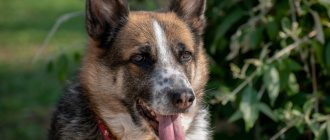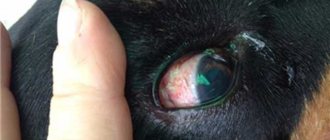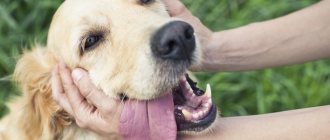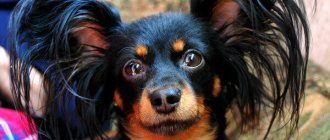In this article we will tell you why dogs grunt. We will describe the main reasons for this phenomenon, such as natural location, entry of a foreign body into the nasal passage, neoplasms, parasites, tracheal collapse, paroxysmal breathing. Let us explain what to do when a dog grunts.
All recommendations described in this article are for informational purposes only. We recommend contacting your veterinarian. Prevention of diseases and successful treatment of pets depends on timely contact with a veterinarian.
Why does the dog grunt?
A dog that makes sounds like grunting is a clear symptom of one of the internal diseases and cannot be ignored. More often this is associated with pathologies of the heart, blood vessels and respiratory organs. This is especially true for decorative breeds with clear signs of inbreeding, which are prone to reverse sneezing and tracheal collapse. Grunting is a familiar sound for brachycephalic pets, but it also means that the dog needs to be taken to the veterinarian twice a year for a preventive examination.
Diagnosis of respiratory organs
As a rule, diagnostics of the respiratory system is carried out according to the following scenario:
- Detailed external examination of the pet , paying attention, first of all, to the condition of all its visible mucous membranes and fur, as well as to the characteristics of breathing (even, intermittent, deep or superficial, etc.).
- Auscultation (listening) of the chest . It is so easy to identify moist rales, “seething” and gurgling in the lungs, and other important symptoms.
- Percussion of the chest (tapping). An experienced specialist can identify changes and shifts in the boundaries of internal organs (lungs and heart), and suggest the presence of fluid or air in the cavity.
TOP 6 causes of grunting sounds in dogs
Why does the dog grunt? This is not a typical sound for canines, so it almost always indicates a pathology, the severity of which only a doctor can understand. The list of possible and frequently diagnosed causes of a grunting sound includes:
- Foreign body in the nasal sinuses.
- Tracheal collapse (often diagnosed in Pugs, Yorkies, Spitz).
- Polyps and tumors in the respiratory tract.
- Aviary cough.
- Reverse sneezing.
- Pharyngitis.
A characteristic symptom when a dog is choking and , at the same time, grunting with its nose indicates heart failure. Often a specific symptom appears during an epileptic seizure.
Parasite infestation
There is a common belief that parasitic worms exclusively affect the gastrointestinal tract, but this is far from the truth. Although the intestines are indeed a favorite place for worms, there are several types of worms that prefer to live in the lungs.
As the colony of worms increases, the breathing of the dog, especially the puppy, will worsen, since the circulation of air masses is inadequate. Again, the danger lies not in grunting or hissing, but in the fact that there have been cases where puppies died, literally suffocating. With progressive helminthic infestation, there is a risk that all offspring will die!
In addition, there are certain types of parasites from the group of nematodes, which spend one of their life cycles in the lungs. In this organ, young individuals receive adequate nutrition for intensive growth and remain here until they grow up. Then they move to the intestines, where their “adult life” begins, followed by reproduction.
While the parasite larvae are in the tissues of the lungs, they injure the organ - the alveoli and bronchi. In addition, after a week and a half, nematodes begin to synthesize specific substances that irritate the mucous surfaces of the respiratory system. This leads to the development of intense coughing and sneezing, and in young animals these signs manifest themselves more actively.
When the dog breathes, gurgling, wheezing sounds are heard, he begins to grunt, sniffle, trying to push air into the lungs with irritated and inflamed walls. If the helminthic infestation has developed to such a clinical picture, a doctor’s consultation is required, since if there is any delay, the dog will develop pneumonia or severe bronchial inflammation.
Tracheal collapse
The etiology of the disease has not been fully studied; it is diagnosed in small breeds of dogs under the age of 2 years. Characteristic symptoms of collapse that you need to pay attention to:
- Dyspnea.
- Convulsive inhalation (“swallowing” of air).
- Cyanosis (blue discoloration) of mucous membranes and tongue.
- Nose grunting.
Due to a critical lack of oxygen, fainting and loss of coordination of movement are common. The dog becomes apathetic and stops playing. Collapse is dangerous in combination with dilated cardiomyopathy, when the parts of the heart are increased in volume.
If tracheal collapse is suspected, an X-ray examination is performed, pictures are taken during inhalation and exhalation. Tracheoscopy is considered a “talking” study, so the diagnosis can be made with 100% accuracy, but there are certain risks when administering anesthesia.
Treatment is surgical; tracheal stenting is indicated. Medicines are prescribed to relieve severe symptoms and ease breathing.
Growl
Such sounds do not always indicate anger or aggression. The animal may growl out of fear. Dogs can growl to react to actions that are unpleasant or painful for them (pricks, claw trimming). With similar sounds they can react to the unknown (strangers entering the house) or protect their resources (toys, food).
Over the week, the number of unemployed in Russia decreased by 200 thousand people
“Hello, I’m an Instagramholic”: Anfisa Chekhova on how she became Instagram addicted
The subject of appeals to the prosecutor's office are violations of rights by employers
However, growling can also be used in a positive way - in playing with other animals, eating bones.
Foreign body
If the dog grunts its nose and behaves as if it is choking, there is a suspicion that a foreign body is stuck in the nasal sinuses and larynx area. Particularly dangerous are bone fragments that scratch and damage the mucous membrane of the larynx with each swallow. On the list of dangerous:
- Nails.
- Needles.
- Glass.
- Small items from children's construction sets, etc.
Difficulty breathing, poor natural passage of air, causes the dog to swallow, strain and inhale convulsively. With a lack of oxygen, visible mucous membranes turn blue, the inside of the cheeks, gums and tongue become cyanotic.
Diagnostics: X-ray. If a foreign body is detected, surgery is performed and the object causing breathing difficulties is removed.
BEIJINGS forum. PEKINGESE FORUM.: He began to arch his back - BEKINGESE forum. PEKINGESE FORUM.
The Pekingese began to arch his back and got sick!
This morning he began to arch his back like a cat, walks slowly, slowly, grunts periodically, as if he is in pain, goes to the toilet normally, yesterday he was still cheerful, but today... you pick him up, it’s like he doesn’t care, he’s absolutely indifferent , what could it be.
This morning he began to arch his back like a cat, walks slowly, slowly, grunts periodically, as if he is in pain, goes to the toilet normally, yesterday he was still cheerful, but today... you pick him up, it’s like he doesn’t care, he’s absolutely indifferent , what could it be.
Show your dog to the doctor, it could be a back problem, a stomach problem, it could be a cold - we took the temperature. How does the dog eat, drink, walk?
no fever, sometimes trembles, eats normally, goes to the toilet normally. but lies in the corner all the time. Unfortunately, we can only go to the vet on Monday, it’s a long way for us to get there, please advise something..
no fever, sometimes trembles, eats normally, goes to the toilet normally. but lies in the corner all the time. Unfortunately, we can only go to the vet on Monday, it’s a long way for us to get there, please advise something..
Did you measure your temperature or did you decide by touch that it was normal!? Does he react somehow when you stroke his back? A baby should not tremble if he is feeling normally.
Before visiting the doctor, I would inject the baby with Traumeel and Discus 1 ml. today and tomorrow + Gamavit 0.3 ML per kg of weight. If he experiences pain, you can add analgin + diphenhydramine. Hold on to this for two days, and be sure to see a doctor on Monday. Maybe Zhenya, our doctor. will go to the forum and write to you more specifically what to do.
Hello! I have a bake
Source
To begin with, I will say that this symptom is repeated for the second time, the first time was in the fall, we were observed by veterinarians in 2 different clinics in Moscow, and no one really told us anything.
The dog is lethargic, or rather, not at all. He constantly lies down or tries to sleep, breathes heavily, his stomach is tense like a stone, if you call the dog he won’t come, if you try to pick him up, he bends like the letter “C” and becomes like a stone! Everything is trembling and shaking! This is already the 3rd day
Reverse sneezing
This sign is more common in dogs of dwarf breeds with a long, narrow muzzle (toy poodle). Outwardly, it looks as if the pet has got something in its nose and is frantically trying to sneeze it out. At the same time, he draws in air and makes grunting sounds, coupled with shortness of breath and noisy breathing.
More often than not, this is not a dangerous symptom. It is necessary to do an ECHO, X-ray and exclude tracheal collapse and heart failure. The attack is short-lived, a maximum of 10 minutes; if you massage the back of the nose, it stops, the dog calms down and stops grunting.
The reasons for this phenomenon have not been studied; there is an assumption that this is due to a certain type of structure of the larynx, as well as dust and pollen entering the nasopharynx. There is no treatment.
Neoplasms of various origins
Tumors in the nasopharynx are diagnosed more often in dogs after 7-8 years of age and cause a specific sound reminiscent of grunting. The first signs appear suddenly in the form of shortness of breath or difficulty swallowing. The faster the tumor grows, the stronger the symptoms; it becomes difficult for the pet to eat and breathe, especially during physical exertion; he tries to “cough up” and remove the interfering tumor.
Carcinomas are found in the larynx, polyps and sarcomas are found in the nose. Favorable prognosis for polyps. If they are detected in a timely manner, surgery is performed and removed. With sarcomas and carcinomas, everything depends on the stage of the pathological process and the degree of tumor penetration into healthy tissue. In case of metastasis to other organs, surgical treatment is not justified.
What to do
Treatment depends on the cause of the wheezing. In the case of foreign bodies, your veterinarian will likely sedate your dog and remove the foreign body using medical instruments. If your dog is wheezing due to infectious causes, treatment will be aimed at eliminating them.
If wheezing is caused by allergic asthma or bronchitis, your veterinarian will tell you about medications that can be used to control the condition and what you can do at home to reduce allergens for your dog, such as vacuuming, HEPA air filters, and so on.
If the wheezing is caused by heart disease, your veterinarian may prescribe medications to help the heart pump blood stronger and more easily. Wheezing due to a collapsed trachea can be treated with cough medicine and monitoring the pet's environment, meaning making sure the pet has a cool place to rest where it can't overheat.
Infectious tracheobronchitis
Another name is kennel cough, a respiratory disease in dogs that occurs in an acute form. Pathology provocateurs are a complex of bacterial and viral pathogens.
The disease becomes widespread in nurseries, packs of stray dogs, shelters, and anywhere where sanitary standards for keeping pets are not observed.
The main symptoms resemble pharyngitis, bronchitis, the dog coughs in fits and starts, grunts through its nose, there is discharge from the eyes and nose, and the regional lymph nodes are enlarged.
Aviary cough with a strong pet’s immunity and timely transfer to good housing, feeding occurs on its own. With the development of secondary infections and non-compliance with hygiene rules in the premises, death is possible.
How to treat
If you notice that your pet has begun to breathe heavily, sneeze and cough, do not leave things to chance, take action and contact a veterinarian.
A cold cough lasts only 2-3 days and goes away on its own. There is no need to treat it; it can harm the health of the animal.
Important ! Do not mindlessly give “human” coughing and expectorant medications to a sick animal. Without knowing the dosage, you can cause an allergic reaction and other side effects.
It should be understood that coughing is only a symptom that can only be correctly interpreted after a complete examination of the dog.
Have your dog checked regularly by a veterinarian
If the animal coughs for 2-3 days, wait; if the condition worsens, go to the veterinary clinic immediately.
Anatomy and breed specifics
Almost all owners of brachycephalic dogs claim that their pet makes “indecent” sounds, sniffles, grunts and snores. This is explained by the specific structure of the pharynx, the soft palate, which, over the course of life, relaxes and falls down, blocking the natural flow of air. Due to selection and reduction in the volume of the skull bones, soft “excess” tissues are collected in folds not only outside (Shar Pei), but also inside. This is inherent:
- French and English bulldogs.
- Pugs.
- Shar Pei.
- Japanese Chin.
Pomeranians and Yorkies are also characterized by similar grunting sounds, although they have a rather elongated and miniature muzzle. The sound increases during physical activity, after 5 years (weakening of tissues), during heat, and excitement. With the development of brachycephalic syndrome, shortness of breath, snoring and grunting sounds occur even when the pet is completely at rest.
Prevention
Any disease is easier to prevent than to cure. Therefore, keep an eye on your pet.
Treatment brings a lot of problems, not only physical, material, but also temporary. Some diseases can be treated within a month, while others cannot be completely cured until the end of the pet’s life.
Follow the general recommendations for the care and maintenance of your Spitz, and there will be no problems with its health.
Regular inspection
Regular periodic examination is mandatory for the presence of various signs that characterize the health of the pet:
Fluffy puppy
- mucous membranes;
- skin;
- wool;
- general activity and motor skills.
Important ! If at least one of the indicators is abnormal, contact your veterinarian.
Visit to the veterinarian
Periodically take your baby to the veterinarian for examination. Preventive diagnostics should be regular so that the disease can be recognized at an early stage.
At the veterinary clinic
You should visit the veterinary hospital at least twice a year, and preferably once every season.










